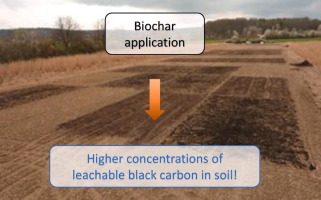当前位置:
X-MOL 学术
›
Org. Geochem.
›
论文详情
Our official English website, www.x-mol.net, welcomes your
feedback! (Note: you will need to create a separate account there.)
Leachable soil black carbon after biochar application
Organic Geochemistry ( IF 2.6 ) Pub Date : 2020-05-01 , DOI: 10.1016/j.orggeochem.2020.103996 Melanie Braun , Arne Kappenberg , Alexandra Sandhage-Hofmann , Eva Lehndorff
Organic Geochemistry ( IF 2.6 ) Pub Date : 2020-05-01 , DOI: 10.1016/j.orggeochem.2020.103996 Melanie Braun , Arne Kappenberg , Alexandra Sandhage-Hofmann , Eva Lehndorff

|
Abstract Black carbon (BC) enters soil via deposition of emissions and nowadays also via application of biochar. Recent studies indicate that a yet not quantified part of BC is lost from soil by leaching, which implies that BC exists in water-transportable form (so-called water-extractable BC; WEBC). We aim at quantifying the amount of WEBC in soil and at elucidating whether it relates to biochar application. The composition of WEBC was further tested to evaluate the degree of BC weathering over time after application, hypothesizing that BC degrades into smaller polyaromatic units. We analysed total BC and WEBC in topsoil (0–10 cm) of a field trial with application of 0, 4.5, and 9 Mg biochar ha−1 using the benzene polycarboxylic acid method. To see if there is a temporal relation between BC input and WEBC formation, we took samples directly after biochar application and three years later. Bulk BC and also WEBC concentrations increased with increasing biochar application rates. In contrast, WEBC portions of bulk BC decreased with increasing amount of applied biochar. On average, we found between 7.56 ± 2.50 and 12.56 ± 1.34 mg WEBC per kg agricultural soil, making up 0.6–1.84% of bulk BC. Over time, no loss or accumulation of either component was observed. However, we found that the composition of WEBC differed from bulk BC; i.e. WEBC consisted of less condensed aromatic structures than bulk BC indicating that de-condensation processes are involved in the formation of leachable BC.
中文翻译:

施用生物炭后可浸出的土壤黑碳
摘要 黑碳 (BC) 通过排放物沉积进入土壤,如今也通过生物炭的应用进入土壤。最近的研究表明,尚未量化的部分 BC 通过浸出从土壤中流失,这意味着 BC 以水可运输的形式存在(所谓的水可提取 BC;WEBC)。我们的目标是量化土壤中 WEBC 的数量,并阐明它是否与生物炭应用有关。进一步测试了 WEBC 的组成,以评估应用后 BC 随时间推移的风化程度,假设 BC 降解为更小的多环芳烃单元。我们使用苯多羧酸方法分析了田间试验表土(0-10 厘米)中的总 BC 和 WEBC,其中施用 0、4.5 和 9 Mg 生物炭 ha-1。要查看 BC 输入和 WEBC 形成之间是否存在时间关系,我们在 biochar 应用后和三年后直接取样。散装 BC 和 WEBC 浓度随着生物炭施用率的增加而增加。相比之下,散装 BC 的 WEBC 部分随着应用 biochar 量的增加而减少。平均而言,我们发现每公斤农业土壤中 7.56 ± 2.50 至 12.56 ± 1.34 毫克 WEBC,占散装 BC 的 0.6-1.84%。随着时间的推移,没有观察到任何一种成分的损失或积累。然而,我们发现 WEBC 的组成与散装 BC 不同;即 WEBC 由比本体 BC 更少稠合的芳族结构组成,这表明去冷凝过程涉及可浸出 BC 的形成。散装 BC 的 WEBC 部分随着应用 biochar 量的增加而减少。平均而言,我们发现每公斤农业土壤中 7.56 ± 2.50 至 12.56 ± 1.34 毫克 WEBC,占散装 BC 的 0.6-1.84%。随着时间的推移,没有观察到任何一种成分的损失或积累。然而,我们发现 WEBC 的组成与散装 BC 不同;即 WEBC 由比本体 BC 更少稠合的芳族结构组成,这表明去冷凝过程涉及可浸出 BC 的形成。散装 BC 的 WEBC 部分随着应用 biochar 量的增加而减少。平均而言,我们发现每公斤农业土壤中 7.56 ± 2.50 至 12.56 ± 1.34 毫克 WEBC,占散装 BC 的 0.6-1.84%。随着时间的推移,没有观察到任何一种成分的损失或积累。然而,我们发现 WEBC 的组成与散装 BC 不同;即 WEBC 由比本体 BC 更少稠合的芳族结构组成,这表明去冷凝过程涉及可浸出 BC 的形成。
更新日期:2020-05-01
中文翻译:

施用生物炭后可浸出的土壤黑碳
摘要 黑碳 (BC) 通过排放物沉积进入土壤,如今也通过生物炭的应用进入土壤。最近的研究表明,尚未量化的部分 BC 通过浸出从土壤中流失,这意味着 BC 以水可运输的形式存在(所谓的水可提取 BC;WEBC)。我们的目标是量化土壤中 WEBC 的数量,并阐明它是否与生物炭应用有关。进一步测试了 WEBC 的组成,以评估应用后 BC 随时间推移的风化程度,假设 BC 降解为更小的多环芳烃单元。我们使用苯多羧酸方法分析了田间试验表土(0-10 厘米)中的总 BC 和 WEBC,其中施用 0、4.5 和 9 Mg 生物炭 ha-1。要查看 BC 输入和 WEBC 形成之间是否存在时间关系,我们在 biochar 应用后和三年后直接取样。散装 BC 和 WEBC 浓度随着生物炭施用率的增加而增加。相比之下,散装 BC 的 WEBC 部分随着应用 biochar 量的增加而减少。平均而言,我们发现每公斤农业土壤中 7.56 ± 2.50 至 12.56 ± 1.34 毫克 WEBC,占散装 BC 的 0.6-1.84%。随着时间的推移,没有观察到任何一种成分的损失或积累。然而,我们发现 WEBC 的组成与散装 BC 不同;即 WEBC 由比本体 BC 更少稠合的芳族结构组成,这表明去冷凝过程涉及可浸出 BC 的形成。散装 BC 的 WEBC 部分随着应用 biochar 量的增加而减少。平均而言,我们发现每公斤农业土壤中 7.56 ± 2.50 至 12.56 ± 1.34 毫克 WEBC,占散装 BC 的 0.6-1.84%。随着时间的推移,没有观察到任何一种成分的损失或积累。然而,我们发现 WEBC 的组成与散装 BC 不同;即 WEBC 由比本体 BC 更少稠合的芳族结构组成,这表明去冷凝过程涉及可浸出 BC 的形成。散装 BC 的 WEBC 部分随着应用 biochar 量的增加而减少。平均而言,我们发现每公斤农业土壤中 7.56 ± 2.50 至 12.56 ± 1.34 毫克 WEBC,占散装 BC 的 0.6-1.84%。随着时间的推移,没有观察到任何一种成分的损失或积累。然而,我们发现 WEBC 的组成与散装 BC 不同;即 WEBC 由比本体 BC 更少稠合的芳族结构组成,这表明去冷凝过程涉及可浸出 BC 的形成。











































 京公网安备 11010802027423号
京公网安备 11010802027423号